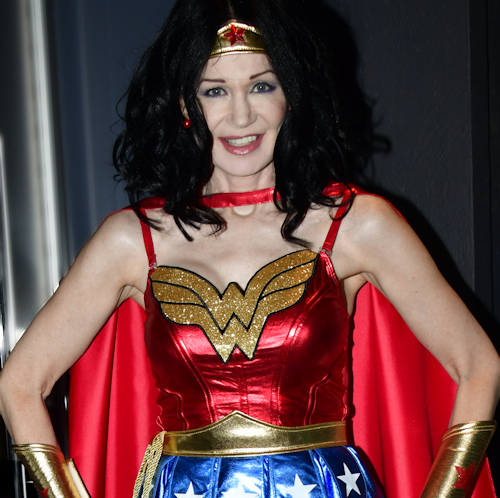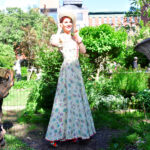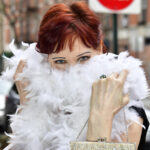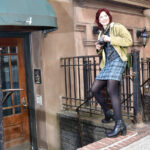
I was a girl during the first golden age of feminist television, from 1976 to 1978, when we had an intoxicating fistful of superwomen role models: Wonder Woman with Lynda Carter, the Bionic Woman starring Lindsay Wagner, and Charlie’s Angels with Farah Fawcett, Jaclyn Smith, and Kate Jackson. Like Wonder Woman herself, who grew up on Paradise Island among Amazon women, I didn’t believe it when anyone told me that I was limited because I was female. I instinctively knew this wasn’t true, and seeing these magical women every week on television helped reinforce my knowledge.
Marching through Midtown in Wonder Woman attire on my way to work at 7:00 AM on a frosty late-October morning, I was shocked by the recognition and adoration I received from my fellow worker bees. Cries of “Wonder Woman!”—sung in the tune of her ’70s TV theme song—rang against the skyscrapers. I won best Halloween costume at work that day, and received even more recognition going home in the after-work crush on 40th Street, in the Subway, and striding down Sixth Avenue. From tots to pensioners, people cried out with delight “It’s Wonder Woman!” They recognized her tiara, bracelets, and boots, and of course the golden Lasso of Truth. Even with her iconic double-W symbol concealed beneath my leather jacket, the flying red cape gave her away.

Wow, that’s a lot of power to own. I like it! So I reprised the role for this month’s column to bring Wonder Woman’s message of super feminine wisdom and power to the pages of this paper. If only I had her ability to fight against evil and make people tell the truth with my golden lasso. Can you imagine? I’d spin the lasso, snag an orange Cheeto and demand the truth: “Who won the election?”
The Wonder Woman character and cartoon was created in 1941 by William Moulton Marston with drawings by illustrator Harry G. Peter. Her viewpoints and characteristics reflect Marston’s, who was a strong supporter of feminist ideals and female empowerment. His wife, Elizabeth, and their polyamorous life partner, Olive Byrne, greatly influenced Wonder Woman’s creation and were his inspiration for the character’s appearance, including her bracelets.
Marston was a psychologist, his wife was a scientist, and together they invented an early prototype of the lie detector. Marston theorized that human relationships could be broken down into dominance, submission, inducement and compliance roles which were embedded into our psyche. He thought that people are happiest when they are submitting to a loving authority. For this reason, Marston believed that women as a sex are many times better equipped to assume emotional leadership than are males. Marston wanted to convey his progressive ideals, through his use of bondage imagery, that women are not only capable of leadership roles, but should be in charge of society. Hence his Wonder Woman—invented during the early years of World War II—was a pacifist icon who used superpowers and smarts (and a little light bondage!) rather than violence to win the day.
Wonder Woman is the most famous female superhero, ranking with Superman and Batman in popularity. She has become an iconic exemplar of the feminist movement and a continuing symbol of female empowerment. Feminist icon Gloria Steinem placed Wonder Woman on the first issue of the Ms. magazine, in 1972.
On October 21, 2016, on the 75th anniversary of the first appearance of her character, the United Nations named Wonder Woman a UN Honorary Ambassador for the Empowerment of Women and Girls in a ceremony attended by UN Secretary-General Ban Ki-moon, Lynda Carter, and Gal Gadot. The gesture was intended to raise awareness of UN Sustainable Development Goal No. 5, which seeks to achieve gender equality and empower all women and girls by 2030. Unfortunately, naysayer UN staffers, who felt her character was overtly sexualized, protested, and the character was stripped of the designation soon afterwards.
While showcasing this cinematic figure—who sprang from the pages of her comic books to the television and later the silver screen—I would also like to commemorate the owner of New York’s first multiplex theater, Quad Cinema at 34 West 13th Street. Maurice Kanbar died in September, at age 93. He was an inventor who held three dozen patents, including his first hit, the D-Fuzz-It Sweater & Fabric Comb.
Another of his creations holds an important place in Manhattan moviegoing history: when the Quad Cinema opened on October 18, 1972, it was the first theater in the city to have multiple screens under one roof. That day the Quad showed three current movies — “Play It Again, Sam,” “Butterflies Are Free,” and “Slaughterhouse-Five” — and the 1943 musical “The Gang’s All Here.” Recently renovated, the Quad’s spectacular theater spaces offer the intimacy and luxury of high-end private screening rooms, each with a unique look and color scheme, state-of-the-art sound, and seats imported from Norway. Plus a wonder feature if you arrive ahead of a friend who’s always late: the Quad Bar! Serving beer and wine, the Quad Bar does not provide Kanbar’s most lucrative invention, a hangover-free vodka called Skyy, which he reportedly sold to Campari Group for $207.5 million in 2001.
Though it was never actually shown at the Quad, the popular 2017 film Wonder Woman, starring Gal Gadot, Chris Pine, and Robin Wright, is playing at Brooklyn’s Skyline Drive-In NYC on Sunday, December 11. According to Zoë Rose Bryant on Rotten Tomatoes, “Wonder Woman is fierce feminist filmmaking at its finest, featuring a powerhouse poignant performance from Gal Gadot, a truly ravishing romance that harkens back to Old Hollywood, and an effervescent sense of earnest optimism.” It’s all about the alliteration! Or view the original TV series on Amazon Prime and revisit a more innocent age.
This article first appeared in The Village Sun.
Style Notes
- DC Comics Wonder Woman attire, including Lasso of Truth, Bracelets of Submission and gold tiara with red star ruby. Party City, 38 W. 14th Street.
- Red suede open-toed cage boots. The Bay, Vancouver.
- “Janet Collection” wavy shoulder-length wig. Wigs and Plus, 37 14th Street.
- Wonder Woman vintage cartoon poster, “Look Back in Wonder: The Story So Far.” DC Comics Vol. 2, No. 49, December 1990. Artful Posters, 194 Bleecker Street.




This outfit suits you!
Thanks, Liessi!
……………….❢✭➤➜❥WoNDER* PhoTOS,,–i LoVVE yOUr VerSiON sOO muCH!, yOu aRe noW My Fave WondErwOmAN!!===BrIllIANt TiE*inS–& ThiNgs i NevEr knEW!!❀✿…❀✿´✱✿ ♥➜❥.& aLWAYS sOoO MucH FuN!!!!!!!!
thaNk YOU!……………….❢✭➤➜❥❀✿…❀✿´✱✿ ♥➜❥.
Thanks, Suzanne! It takes a WonderWoman to know one! ♥
♥




